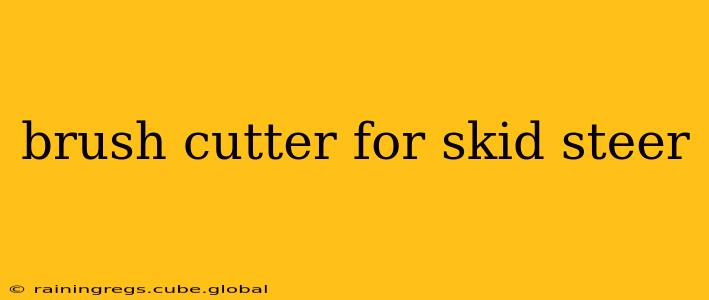Skid steers are incredibly versatile machines, and adding a brush cutter attachment dramatically expands their capabilities. Whether you're clearing land for construction, maintaining trails, or tackling overgrown vegetation, a brush cutter can significantly increase efficiency and productivity. But with so many options available, choosing the right brush cutter for your skid steer can feel overwhelming. This comprehensive guide will help you navigate the process and select the perfect attachment for your needs.
What is a Skid Steer Brush Cutter?
A skid steer brush cutter is a rotary cutting attachment that mounts to the front of a skid steer loader. It utilizes a spinning cutting deck equipped with blades or flails to efficiently cut down brush, small trees, and other vegetation. These attachments are powerful and effective, capable of handling tough terrain and dense overgrowth that would be challenging to manage manually. The choice between a flail mower and a blade-style cutter significantly impacts performance and application.
What are the Different Types of Skid Steer Brush Cutters?
Flail Mowers:
Flail mowers utilize numerous swinging flails instead of fixed blades. This design offers several advantages:
- Superior obstacle avoidance: Flails flex and deflect when encountering rocks or other hard objects, reducing the risk of damage to the cutter or the skid steer.
- Finely chopped material: The flails create finely chopped mulch, ideal for land clearing and mulching applications.
- Better for uneven terrain: The flexibility of the flails allows for smoother operation on uneven ground.
Blade Cutters:
Blade cutters, on the other hand, feature fixed blades that rotate at high speed. They're typically more effective at cutting larger diameter brush and saplings than flail mowers. However, they are more susceptible to damage from obstacles.
- More powerful cutting: Ideal for thicker vegetation and small trees.
- Less material chopping: Creates larger pieces of cut vegetation.
- Better for flat terrain: Generally less effective and potentially damaging on uneven surfaces.
How to Choose the Right Brush Cutter for Your Skid Steer?
Selecting the appropriate brush cutter depends on several factors:
- Cutting width: This determines the area covered in each pass. Wider cuts mean faster clearing but may require more powerful skid steers.
- Horsepower requirements: Ensure your skid steer has sufficient horsepower to effectively operate the chosen brush cutter. Underpowering can lead to poor performance and potential damage.
- Type of vegetation: The type of vegetation you intend to cut dictates the type of cutter (flail or blade) and cutting width. Dense brush might need a powerful flail mower, while smaller saplings could be managed with a blade cutter.
- Terrain conditions: Uneven terrain favors flail mowers due to their flexibility and obstacle avoidance capabilities.
What are the Safety Precautions When Using a Skid Steer Brush Cutter?
Safety should always be the top priority when operating heavy machinery. Here are some essential safety precautions:
- Wear appropriate personal protective equipment (PPE): This includes safety glasses, hearing protection, gloves, and sturdy footwear.
- Clear the area of obstacles: Remove any rocks, debris, or other objects that could damage the cutter or cause injury.
- Inspect the attachment before use: Check for any loose parts, worn blades, or other potential hazards.
- Operate at a safe speed: Avoid operating the brush cutter at excessively high speeds, especially on uneven terrain.
- Be aware of your surroundings: Pay attention to your surroundings and be mindful of other people or equipment in the vicinity.
What are the Maintenance Requirements for a Skid Steer Brush Cutter?
Regular maintenance is crucial for ensuring the longevity and efficiency of your brush cutter:
- Inspect the blades/flails regularly: Check for wear, damage, or dullness. Replace worn or damaged components as needed.
- Lubricate moving parts: Follow the manufacturer's recommendations for lubrication intervals and procedures.
- Check the belts and pulleys: Inspect for wear, fraying, or misalignment. Replace worn components as needed.
- Clean the cutting deck: Remove any accumulated debris or vegetation to prevent clogging and improve cutting efficiency.
How Much Does a Skid Steer Brush Cutter Cost?
The cost of a skid steer brush cutter varies depending on the size, type, and brand. Prices can range from a few thousand dollars to upwards of ten thousand dollars for larger, more heavy-duty models.
What are the Benefits of Using a Skid Steer Brush Cutter?
Using a skid steer brush cutter offers many benefits over manual clearing methods:
- Increased efficiency: Significantly faster and more efficient than manual clearing.
- Improved safety: Reduces the risk of injuries associated with manual clearing.
- Reduced labor costs: Minimizes the need for manual labor.
- Better land management: Enables precise and controlled vegetation management.
By carefully considering these factors and following appropriate safety procedures, you can maximize the effectiveness and longevity of your skid steer brush cutter, making your land clearing projects more efficient and productive. Remember to always consult your owner's manual for specific instructions and maintenance recommendations for your particular model.
